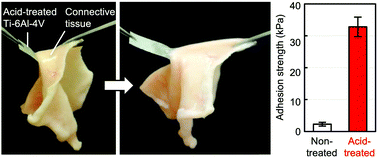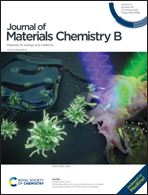Immediate soft-tissue adhesion and the mechanical properties of the Ti–6Al–4V alloy after long-term acid treatment†
Abstract
Close attachment of soft tissues onto implantable devices inside the body is regarded as an optimal condition for preventing complications (e.g., infections and abscess formation around implants, and the migration of small injectable devices). We have recently reported that an α-type commercially pure Ti (CpTi) film after a long-term acid treatment and air drying showed a remarkable soft tissue adhesiveness immediately (i.e., within a few seconds) after the attachment onto soft tissues. Herein, we conducted acid treatment for (α + β)-type Ti–6Al–4V alloys and compared their mechanical properties and the immediate soft-tissue adhesiveness with α-type CpTi. The acid treatment for Ti–6Al–4V also promoted immediate soft-tissue adhesion, although the treatment was less effective than for CpTi. The tensile strength of acid-treated Ti–6Al–4V was much higher than that of acid-treated CpTi or human skin tissues, although the degree of hydrogen embrittlement was more severe than that for CpTi. These results suggest that the small amount of Al in the major α phase and/or the minor β phase of Ti–6Al–4V has a significant influence not only on the mechanical properties but also on the immediate soft-tissue adhesiveness of Ti-based solid-state adhesives after the acid treatment.

- This article is part of the themed collection: Journal of Materials Chemistry B Lunar New Year collection 2022


 Please wait while we load your content...
Please wait while we load your content...